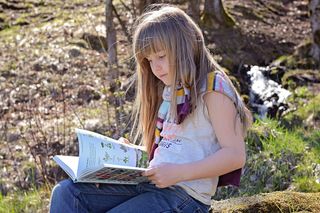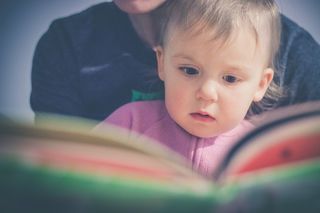Adolescence
How to Get Your Children to Read More
Proven ways to instill the joy of reading in your toddler or reluctant teen.
Posted September 3, 2019

Once a year, out of town friends visit for several days. I have to be sure to have a stack of books on hand for Allie, their now 17-year-old daughter. She plows through them—one after another. The cell phone at her side doesn’t seem to slow down her reading. Reading has been her default preference since she started reading by herself.
I asked her mother how she had turned Allie into such a voracious reader. Her mother says she has no idea. But, when pressed I learned:
- My friend read to Allie’s older brother when she was breastfeeding Allie.
- She read to her children every night before bed and acquiesced to “one more book, Mom, please” almost every time she was asked.
- From very young ages, she allowed the children to choose the books for bedtime reading, to borrow from the library or buy at the bookstore.
- Allie read to her stuffed animals before she could really read.
- Allie read to the dog and cat.
Parents like Allie’s mother like to say, "My child is a natural born reader." Whatever the reason, it’s a delight to see a teenager with a book, not incessantly texting or playing games on a digital device. Having children who love to read is probably not genetic or magic…and some children need more prodding than others. However, it is easier to turn your child into a reader whatever his age than you think and has some outcomes you likely never considered.
Benefits Beyond Building Brain Circuits
It’s well documented that children who read regularly do better academically, that reading boosts critical thinking and imagination and improves language skills. Other recent findings will encourage you to want to foster your children’s lifelong love of reading:
Manuel Jimenez, Assistant Professor of Pediatrics and Family Medicine and Community Health at Rutgers University, followed reading patterns of over 2,000 urban mothers (many of whom were single mothers), when their children were ages 1, 3, and 5 and found that shared reading (reading to their child) during the early developmental stages resulted in not only less harsh parenting, but also shared reading was consistently associated with reduced hyperactive and disruptive behavior in the children—often a trigger for harsh parenting. The study, “Early Shared Reading is Associated with Less Harsh Parenting,” reported in the Journal of Developmental & Behavioral Pediatrics, supports the American Academy of Pediatrics’ recommendations.
The American Academy of Pediatrics advises pediatricians to remind parents “that reading aloud with their young children can enrich parent-child interactions and relationships, which enhances their children’s social-emotional development while building brain circuits to prepare children to learn language and early literacy skills.”
A study published in the Journal of Research in Reading underscores a parent’s role and involved 70 sets of six- and seven-year-old children and their parents. The children were given reading material just above their tested reading levels. The researchers, Aviva Segal and Sandra Martin‐Chang, found that parents who read and have what the study authors refer to as “higher reading related knowledge (including the ability to spot difficulties a child is having),” are likely to have children with higher reading scores. Most interesting is that the parents with “higher reading knowledge” were less likely to criticize their children’s reading errors and offered more praise to their children than parents with lower reading-related knowledge. They also paid more attention when their children read aloud to them. A lesson for parents who tend to be distracted or engaged in something else when their child is trying to get them to listen. Listening is a powerful tool for connecting with children whether around reading or their development in general.
How to Turn Your Child into a Reader
You can limit screen time, impose all variations of digital detox, but beyond the clear benefits of reading, the desire to read ultimately has to come from within your child. Parents provide the building blocks, all of which are spelled out in How to Raise a Reader. Pamela Paul, New York Times book editor, and Maria Russo, New York Times children’s book editor have done a parent’s homework.
Allie’s mother didn’t have all the answers for turning a child into a reader, but How to Raise a Reader does, offering sage advice including hundreds of book recommendations beginning with books for babies and toddlers, even YAs, plus adult fiction and nonfiction books for teenagers. A parent can dip in at whatever age their child is now—a baby, a beginning reader, middle-grade or teenage reader.
Reading with Toddlers

Your toddler, for example, may latch on to a favorite and it could be a book you prefer would conveniently disappear. When my son was a toddler, it was a version of Richard Scarry's Cars and Trucks and Things That Go. Tedious for his parents, but intensely satisfying to our son. In that case, Paul and Russo suggest introducing books on the same or related topics.
In a section, titled “Pro Tips for Reading Out Loud” to your toddler, the authors provide helpful pointers as they do in every age-related section of the book:
- We read a book out loud with a child, rather than to a child.
- To teach an appreciation of how books are created, begin with the title, author and illustrator’s names. Even ask, “What do you think this one is going to be about?”
- It’s okay to substitute a word that you think is beyond your child’s comprehension…or to shorten a paragraph.
- Interruptions tell you that your child is listening. If she asks questions or comments, stop reading to hear what she has to say.
- Let him take charge of turning pages and the pace.
- Read more slowly than you think is natural or sing some of the passages.
- Be aware that your child isn’t always hearing exactly the same story you are. Ask her what she sees in the illustrations.
- Point out objects on the page and ask what they are or what is happening.
As the authors note, “School is where children learn that they have to read. Home is where they can learn to love it.” Although as a parent you are gifting your child a love of reading, How to Raise a Reader is a gift to you as well.
Related: Why Jane Reads Better Than Jack--How gender stereotypes affect students’ reading.
Copyright @2019 by Susan Newman
References
Jimenez, Manuel E., Alan L. Mendelsohn, Yong Lin, Patricia Shelton, Nancy Reichman. (2019) "Early Shared Reading is Associated with Less Harsh Parenting." Journal of Developmental & Behavioral Pediatrics, 1 DOI: 10.1097/DBP.0000000000000687
Paul, Pamela and Russo, Maria. (2019). How to Raise a Reader. New York: Workman Publishing.
Segal, Aviva and Sandra Martin‐Chang. (2019)" ‘What does an O say when there's no E at the end?’ Parents' reading‐related knowledge and feedback during child‐to‐parent reading." Journal of Research in Reading: 42 (2): 349 DOI: 10.1111/1467-9817.12272
Council on Early Childhood. The American Academy of Pediatrics. (2014). "Literacy Promotion: An Essential Component of Primary Care Pediatric Practice." Pediatrics: VOLUME 134 / ISSUE 2.




